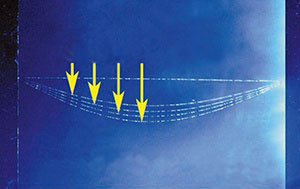| Oct 17, 2011 |
Carbon nanotubes: Pure storage power
|
|
(Nanowerk News) Mechanical energy is stored in many physical systems, such as in the springs that power clocks and even in the water reservoirs that drive hydroelectric power generators. Storing mechanical energy on the nanoscale could also lead to some interesting device applications. Carbon nanotubes (CNTs) have been investigated for this purpose, but it has proved difficult to create the strong, defect-free CNTs needed to withstand the repeated stretching required to store mechanical energy effectively. Wei Fei and colleagues from Tsinghua University in Beijing and the Chinese Academy of Sciences in Shenyang have now succeeded in producing ultralong defect-free CNTs and demonstrating their potential for use in nanoscale mechanical energy storage ("Superstrong Ultralong Carbon Nanotubes for Mechanical Energy Storage").
|
 |
| Microscopy image showing the TiO2-bearing carbon nanotube suspended across a 750 µm-wide gap and subjected to nitrogen gas flow at various speeds (yellow arrows). (© 2011 Wiley-VCH)
|
|
"We set out to produce 'perfect' CNTs without defects," says Wei. CNTs without defects are much more durable than lower-quality CNTs, and so can withstand repeated mechanical stress — a property that grants them an extraordinary capacity for storing mechanical energy. The researchers grew their ultralong CNTs using a recently developed technique that involved exposing iron catalyst particles on a specially designed silicon substrate to a stream of methane gas. The CNTs grew to lengths of 10–20 cm by a kite mechanism in the gas flow.
|
|
The researchers then investigated the mechanical properties of the CNTS by fixing them across a 750 ?m-wide gap and exposing them to a high-speed flow of nitrogen gas (see image) and then sound from a loudspeaker. The behavior of the CNTs under these physical stresses was monitored by spraying the nanotubes with nanoparticles of titanium dioxide, which could be visualized easily by high-speed camera.
|
|
The tests revealed the CNTs to have remarkable mechanical durability with the ability to store mechanical energy at energy densities 5–8 times higher than that of lithium batteries, and 25,000 times that of steel springs. The stored energy could be used to power nano- and microelectromechanical systems.
|
|
The challenge now, Wei explains, is harnessing the storage power of CNTs. "We are now attempting to make a nano-electricity generator driven entirely by the mechanical energy stored in CNTs," he says. The researchers also intend to refine their fabrication techniques to allow pure, long CNTs to be produced on a larger scales.
|

